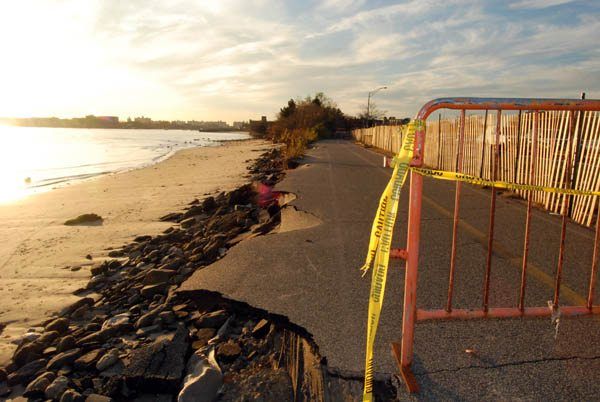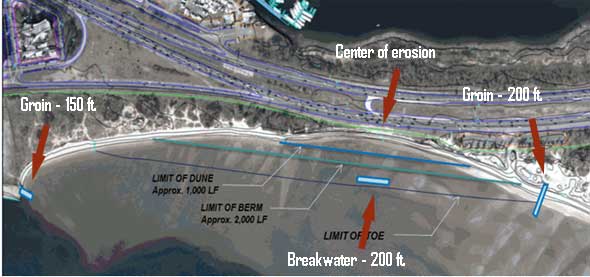Plumb Beach Restoration Plans Outlined, Construction Could Begin As Early As December

U.S Army Corps of Engineers and city officials are working together to save Plumb Beach and the Belt Parkway from catastrophe, and have come up with a set of proposals for the long-term sustainability of the parkland and transportation infrastructure.
Plumb Beach, once providing 40 feet of beachfront, has been reduced to just a few yards due to the nor’easter back in 2009. The storm swept away sand, ruined a section of the bike path, and nearly flooded the highway. The extremely eroded beach is in desperate need of construction, which can range anywhere from one to five million dollars.
U.S Army Corps of Engineers is ready to take action. Their main concern is not only to choose the best solution to restore the beach, but to solve long-term erosion issues.
(The plans outlined below will be presented at a public hearing at the Salt Marsh Nature Center, in Marine Park at Avenue U and East 33rd Street, at 6:00 p.m, on Thursday, February 24. It may be the only opportunity for residents and activists to ask questions and express concerns about the proposals in person.)
“We want to make sure that there is a beach there in the future… beach fill wont be enough because the sand will wash away as it did in the past,” said Daniel Falt, the project manager for the U.S Army Corps of Engineers.
The options that will be used in the operation include beach fill, groins – also known as jetties – and breakwaters, but one or even two options combined are simply not enough to restore the beach and prevent it from long term erosion.
“You got to be very careful with these projects… beach fill and groins wont be enough,” said Ida Sanoff, chairperson of the Natural Resources Protective Association. Sanoff is reserving judgement on the Corps’ plans until after a public hearing this week, but said that continuous maintenance needs to be a key component of any solution.
Plumb Beach currently has sand bags laid out to protect the highway from flooding. According to Falt, the sand bags should last up to five years, but Sanoff and others scoff at the claims.
“The sand bags are a joke. Even the groins are a joke,” Sanoff said. “None of these structures are perfect; none of these things that they are going to do is going to be a permanent solution. It all depends on what they are proposing in terms of long-term maintenance.”
The U.S Army of Engineers will propose a number of alternatives to see which works the best. In all scenarios, they’ve included beach fill. They plan to fill the beach with 70,000 to 100,000 cubic yards of sand. The sand will most likely come from the channel dredging of the Jamaica Bay Inlet, which is located between Rockaway, Queens and Sheepshead Bay, Brooklyn. Otherwise they will get the sand from the Ambrose channel, which is further out into the harbor. The sand will be pumped in through a pipe from a dredge boat and moved around with a bulldozer, this process should take about 20 days of work, Falt said. But even he admits it won’t be enough.
“It wouldn’t be worth it to fill the beach with sand alone,” Falt said. “The sand moves south, east, and west … We need to control the sand with either groins or breakwaters, or both.”
(Article continues after diagram.)

Another, option believed to be more effective is to fill the beach with sand and build two terminal groins at both ends of the beach.
“The stones will be sized to resist any of the storms’ wave energy, appropriately sized to prevent the erosion,” said Falt. Groin construction should take about a month, with barges or trucks delivering large stones and placing them jutting out perpendicular to the shoreline. This option, he said, may be the most cost effective, despite flaws, which include routine maintenance where workers take sand that has gathered at the groins and return it to the depleted spot.
The third and most comprehensive option, which will control erosion the longest is to fill the beach with sand, construct two terminal groins, and install a breakwater.
At about 200 feet long, a breakwater is a long, narrow stone island that would run parallel to the beach, and will be located at the center where most of the erosion occurs. The construction should take about a month of work, using a barge boat to put the stones in place with a crane. Unlike groins, breakwaters are designed to reduce the amount of sediment that’s brought into the beach, as well as weaken waves before they crash into the shore.
“This option does the most for long term, but it is going to be extremely costly,” said Community Board 15 Chairperson Theresa Scavo.
The operation, costing up to $5,000,000, will be funded mostly by federal funds – 65 percent – with the remainder being picked up by the New York City Parks Department.
There is a fourth option that no one considers acceptable: do nothing. The Corps’ overview notes that the city could choose to simply maintain the sandbags for the next five years, while the shoreline continues to retreat. At that point, the city would install 1,200 feet of bulkhead to protect the Belt Parkway – the beach in the eroded part would no longer exist. That would last 30 years, after which erosion would have damaged more sections of the beach, and the city would need to install an additional 1,000 feet of bulkhead. This option, though cheaper in the short-run, is seen as unlikely.
The U.S Army Corps of Engineers is currently working on the feasibility reports on the different alternatives. They hope to begin construction in December 2011.
“We are going to pick the one option that works the best, that controls the erosion, keeps it there the longest, and is most suitable to our constraints,” Falt said.




